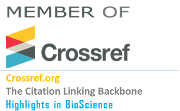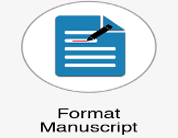Identifying Genetic Linkage Groups and Markers for Leaf Miner Resistance in Chickpea through QTL Analysis and Field Validation
Abstract
Keywords
Full Text:
View Full TextReferences
Jukanti AK, Gaur PM, Gowda C, Chibbar RN. Nutritional quality and health benefits of chickpea (Cicer arietinum L.): a review. British Journal of Nutrition. 2012;108(S1):S11-26.
Santra D, Ratnaparkhe M, Muelhbauer F, Kaiser WJ. Identification and mapping of QTLs conferring resistance to ascochyta blight in chickpea. 2000.
Çıkman E, Civelek HS. Population densities of Liriomyza cicerina (Rondani, 1875)(Diptera: Agromyzidae) on Cicer arietinum L.(Leguminosae: Papilionoidea) in different irrigated conditions. 2006.
Knights E, Acikgoz N, Warkentin T, Bejiga G, Yadav S, Sandhul I. Area, production and distribution. Chickpea breeding and management. 2007:167-78.
Faostat F, Production AC. Food and agriculture organization of the united nations, 2014. Roma, Italy. 2014.
Moreno MT, Cubero J. Variation in Cicer arietinum L. Euphytica. 1978;27:465-85.
Istanbuli T, Baum M, Touchan H, Hamwieh A, et al. Evaluation of morpho-physiological traits under drought stress conditions in barley (Hordeum vulgare L.). Photosynthetica. 2020;58(4):1059-67.
Dahal PP, Basnet KB, Sah SK, Karki TB. Effect of weather parameters on growth stages of winter maize ex-plain the grain yield. Highlights in BioScience. 2021;4.
Singh K, Weigand S. Identification of resistant sources in Cicer species to Liriomyza cicerina. Genetic Resources and Crop Evolution. 1994;41(2):75-9.
El Bouhssini M, Mardini K, Malhotra R, Joubi A, Kagka N. Effects of planting date, varieties and insecticides on chickpea leaf miner (Liriomyza cicerina R.) infestation and the parasitoid Opius monilicornis F. Crop Protection. 2008;27(6):915-9.
Perveen FK. Insecticides: Advances in integrated pest management. BoD–Books on Demand; 2012.
Egan LM, Stiller WN. The Past, Present, and Future of Host Plant Resistance in Cotton: An Australian Perspective. Frontiers in Plant Science. 2022;13.
Sharma H, Bhagwat M, Pampapathy G, Sharma J, Ridsdill-Smith T. Perennial wild relatives of chickpea as potential sources of resistance to Helicoverpa armigera. Genetic Resources and Crop Evolution. 2006;53(1):131-8.
Nassar AE, Mousa KH, Madbouly AA, Ibrahim SD, Alsamman AM. Identification of genes for wheat fungal resistance using bioinformatics techniques. Highlights in BioScience. 2018;1:1-10.
Khoja S, El Bouhssini M, Malhotra R, Kahka N, Abdulhai M. Categories of Resistance of Some Chickpea Lines to Chickpea Leaf Miner Liriomyza cicerina Rondani. Arab Journal of Urology. 2012 12.
Chrigui N, Sari D, Sari H, Eker T, Cengiz MF, Ikten C, et al. Introgression of resistance to leafminer (Liriomyza cicerina Rondani) from Cicer reticulatum Ladiz. to C. arietinum L. and relationships between potential biochemical selection criteria. Agronomy. 2020;11(1):57.
Toker C, Adak A, Sari D, Sari H, Ceylan F, Canci H, et al. Registration of AWC 612M chickpea mutant germplasm line resistant to leaf miner (Liriomyza cicerina). Journal of Plant Registrations. 2019;13(1):87-90.
Yoshida M, Cowgill SE, Wightman JA. Mechanism of resistance to Helicoverpa armigera (Lepidoptera: Noctuidae) in chickpea: role of oxalic acid m leaf exudate as an antibiotic factor. Journal of Economic Entomology. 1995;88(6):1783-6.
Hassan AH, El-Heba GA, Mohamed A, et al. DNA Variations between Medicago truncatula Symbiotic Mutant Line and Native Variant Using Fluorescence-Based AFLP Marker. Highlights in BioScience. 2020;3:1-5.
Collard B, Pang E, Ades P, Taylor P. Preliminary investigation of QTLs associated with seedling resistance to ascochyta blight from Cicer echinospermum, a wild relative of chickpea. Theoretical and Applied Genetics. 2003;107(4):719-29.
Paterson AH. What has QTL mapping taught us about plant domestication? New Phytologist. 2002;154(3):591-608.
Paterson A. Mapping genes responsible for differences in phenotype. Genome mapping in plants. 1996:41-54.
Botstein D, White RL, Skolnick M, Davis RW. Construction of a genetic linkage map in man using restriction fragment length polymorphisms. American journal of human genetics. 1980;32(3):314.
Hüttel B, Winter P, Weising K, Choumane W, Weigand F, Kahl G. Sequence-tagged microsatellite site markers for chickpea (Cicer arietinum L.). Genome. 1999;42(2):210-7.
Huettel B, Santra D, Muehlbauer F, Kahl G. Resistance gene analogues of chickpea (Cicer arietinum L.): isolation, genetic mapping and association with a Fusarium resistance gene cluster. Theoretical and Applied Genetics. 2002;105(2):479-90.
Rajesh P, Tekeoglu M, Gupta V, Ranjekar P, Muehlbauer F. Molecular mapping and characterization of an RGA locus RGAPtokin1-2 171 in chickpea. Euphytica. 2002;128(3):427-33.
Lichtenzveig J, Scheuring C, Dodge J, Abbo S, Zhang HB. Construction of BAC and BIBAC libraries and their applications for generation of SSR markers for genome analysis of chickpea, Cicer arietinum L. Theoretical and Applied Genetics. 2005;110(3):492-510.
Sethy NK, Shokeen B, Edwards KJ, Bhatia S. Development of microsatellite markers and analysis of intraspecific genetic variability in chickpea (Cicer arietinum L.). Theoretical and Applied Genetics. 2006;112(8):1416-28.
Sethy NK, Choudhary S, Shokeen B, Bhatia S. Identification of microsatellite markers from Cicer reticulatum: molecular variation and phylogenetic analysis. Theoretical and Applied Genetics. 2006;112(2):347-57.
Van Ooijen J. JoinMap 4. Software for the calculation of genetic linkage maps in experimental populations Kyazma BV, Wageningen, Netherlands. 2006;33.
Ulloa M, Meredith Jr W, Shappley Z, Kahler A. RFLP genetic linkage maps from four F 2.3 populations and a joinmap of Gossypium hirsutum
L. Theoretical and Applied Genetics. 2002;104:200-8.
Kosambi DD. The estimation of map distances from recombination values. In: DD Kosambi. Springer; 2016. p. 125-30.
Li H, Ye G, Wang J. A modified algorithm for the improvement of composite interval mapping. Genetics. 2007;175(1):361-74.
Azough Z, Kehel Z, Benomar A, Bellafkih M, Amri A. Predictive Characterization of ICARDA Genebank Barley Accessions Using FIGS and Machine Learning. In: Intelligent Environments (Workshops); 2019. p. 121-9.
Rajendran K, Smouni A, Es-Safi NE, Benbrahim N, Mentag R, Nayyar H, et al. Screening the FIGS set of lentil (Lens culinaris Medikus) germplasm for tolerance to terminal heat and combined drought-heat stress. Agronomy. 2020;10(7):1036.
Liu K, Muse SV. PowerMarker: an integrated analysis environment for genetic marker analysis. Bioinformatics. 2005;21(9):2128-9.
Alsamman AM, Ibrahim SD, Hamwieh A. KASPspoon: an in vitro and in silico PCR analysis tool for high-throughput SNP genotyping. Bioinformatics. 2019;35(17):3187-90.
Varshney RK, Song C, Saxena RK, Azam S, Yu S, Sharpe AG, et al. Draft genome sequence of chickpea (Cicer arietinum) provides a resource for trait improvement. Nature biotechnology. 2013;31(3):240-6.
Toker C, Erler F, Ceylan FO, Canci H. Severity of leaf miner [Liriomyza cicerina (Rondani, 1875)(Diptera: Agromyzidae)] damage in relation to leaf type in chickpea. Turk Entomol Derg. 2010;34(2):211-25.
Singh K, Weigand S, et al. Registration of three leafminer-resistant chickpea germplasm lines: ILC 3800, ILC 5901, and ILC 7738. Crop Science. 1996;36(2).
Atta M, Haq A, Shah M, Alam S, Ali H, Akhtar K. Chickpea germplasm screening for resistance against Ascochyta Blight. Journal of Economic Entomology. 2006;18(2):137-50.
Sithanantham S, Reed W, et al. Preliminary observations on Heliothis and other insect pests of chickpea in Syria. International Chickpea Newsletter. 1980;(2).
Taleei A, Kanouni H, Baum M. Genetical studies of ascochyta blight resistance in chcikpea. Int J Biosci Biotechnol. 2010;2:19-28.
Faris J, Laddomada B, Gill B. Molecular mapping of segregation distortion loci in Aegilops tauschii. Genetics. 1998;149(1):319-27.
Kärkkäinen K, Koski V, Savolainen O. Geographical variation in the inbreeding depression of Scots pine. Evolution. 1996;50(1):111-9.
Slocum M, Figdore S, Kennard W, Suzuki J, Osborn T. Linkage arrangement of restriction fragment length polymorphism loci in Brassica oleracea. Theoretical and Applied Genetics. 1990;80(1):57-64.
Pillen K, Steinrücken G, Wricke G, Herrmann R, Jung C. A linkage map of sugar beet (Beta vulgaris L.). Theoretical and Applied Genetics. 1992;84(1):129-35.
Wagner H, Weber W, Wricke G. Estimating linkage relationship of isozyme markers and morphological markers in sugar beet (Beta vulgaris L.) including families with distorted segregations. Plant Breeding. 1992;108(2):89-96.
Kammholz SJ, Campbell A, Sutherland M, Hollamby G, Martin P, Eastwood R, et al. Establishment and characterisation of wheat genetic mapping populations. Australian Journal of Agricultural Research. 2001;52(12):1079-88.
Laucou V, Haurogné K, Ellis N, Rameau C. Genetic mapping in pea. 1. RAPD-based genetic linkage map of Pisum sativum. Theoretical and Applied Genetics. 1998;97(5):905-15.
Winter P, Benko-Iseppon AM, Hüttel B, Ratnaparkhe M, Tullu A, Sonnante G, et al. A linkage map of the chickpea (Cicer arietinum L.) genome based on recombinant inbred lines from a C. arietinum× C. reticulatum cross: localization of resistance genes for fusarium wilt races 4 and 5. Theoretical and Applied Genetics. 2000;101(7):1155-63.
Duran Y, Fratini R, Garcia P, Perez De La Vega M. An intersubspecific genetic map of Lens. Theoretical and Applied Genetics. 2004;108(7):1265-73.
Sherman J, Weaver D, Hofland M, Sing S, Buteler M, Lanning S, et al. Identification of novel QTL for sawfly resistance in wheat. Crop Science. 2010;50(1):73-86.
Xu S. Quantitative trait locus mapping can benefit from segregation distortion. Genetics. 2008;180(4):2201-8.
Rubeena TP, Ford R, Taylor P. Molecular mapping the lentil (Lens culinaris ssp. culinaris) genome. Theor Appl Genet. 2003;107:910-6.
Rector BG. Genetic mapping of antibiosis and antixenosis resistance mechanisms in soybean. University of Georgia; 1998.
Terry L, Chase K, Jarvik T, Orf J, Mansur L, Lark K. Soybean quantitative trait loci for resistance to insects. Crop Science. 2000;40(2):375-82.
Guo B, Zhang Z, Li R, Widstrom N, Snook M, Lynch R, et al. Restriction fragment length polymorphism markers associated with silk maysin, antibiosis to corn earworm (Lepidoptera: Noctuidae) larvae, in a dent and sweet corn cross. Journal of economic entomology. 2001;94(2):564-71.
Lee E, Byrne P, McMullen M, Snook M, Wiseman B, Widstrom N, et al. Genetic mechanisms underlying apimaysin and maysin synthesis and corn earworm antibiosis in maize (Zea mays L.). Genetics. 1998;149(4):1997-2006.
Gullner G, Komives T, Király L, Schröder P. Glutathione S-transferase enzymes in plant-pathogen interactions. Frontiers in plant science. 2018;9:1836.
Boller T, He SY. Innate Immunity in Plants: An Arms Race Between Pattern Recognition Receptors in Plants and Effectors in Microbial Pathogens. Science. 2009;324(5928):742-4. Available from: https://www.science.org/doi/abs/10.1126/science.1171647.
Wahibah NN, Tsutsui T, Tamaoki D, Sato K, Nishiuchi T. Expression of barley Glutathione S-Transferase13 gene reduces accumulation of reactive oxygen species by trichothecenes and paraquat in Arabidopsis plants. Plant Biotechnology. 2018;35(1):71-9.
Radwan EM, Taha HS. Toxic and biochemical effects of different insecticides on the tomato leafminer, Tuta absoluta (Meyrick)(Lepidoptera: Gelechiidae). Egyptian Academic Journal of Biological Sciences, F Toxicology & Pest Control. 2012;4(1):1-10.
Mostafa AA, El-Rahman SNA, Shehata S, Abdallah NA, Omar HS. Assessing the effects of a novel biostimulant to enhance leafminer resistance and plant growth on common bean. Scientific reports. 2021;11(1):1-14.
DOI: https://doi.org/10.36462/H.BioSci.202306
Refbacks
- There are currently no refbacks.
Copyright (c) 2023 Ali et al

This work is licensed under a Creative Commons Attribution 4.0 International License.
...........................................................................................................................................................
Other "Highlights in" Journals
Highlights in Bioinformatics, Highlights in Chemistry, Highlights in Science, Highlights in Microbiology, Highlights in Plant Science
........................................................................................................................................
International Library of Science "HighlightsIn" is an Open Access Scientific Publishers, aiming to science and knowledge support













